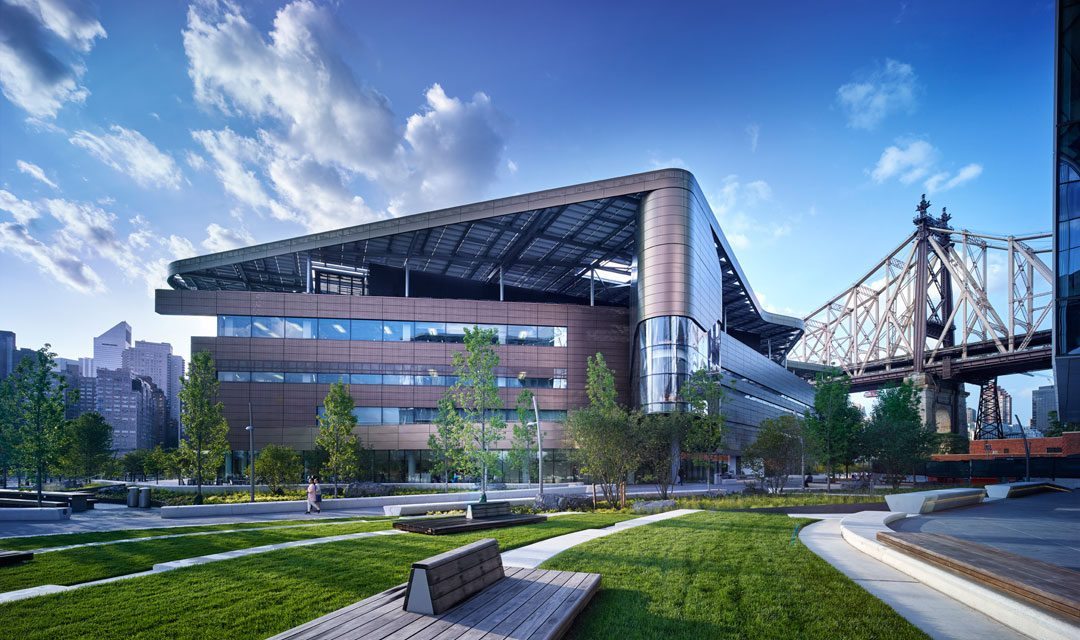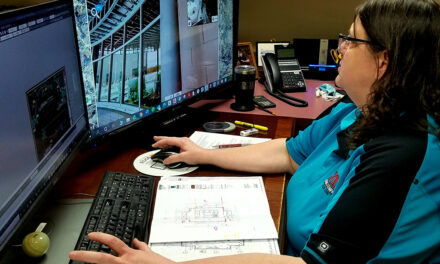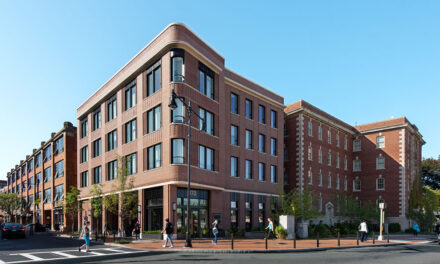The building has ambitious sustainability goals, including LEED Platinum certification and net-zero energy
NEW YORK — Arup, the global design and consulting firm for the built environment, last month celebrated the opening of The Emma and Georgina Bloomberg Center at Cornell Tech’s Roosevelt Island campus. The building, designed by Arup and Morphosis architects, under the direction of Pritzker Prize-winner Thom Mayne and Principal Ung-Joo Scott Lee, is a departure from traditional academic facilities, with a variety of spaces designed to support different learning modes, including flexible spaces to encourage collaboration as well as private work spaces, adapting open-plan offices from the tech world to the academic arena.
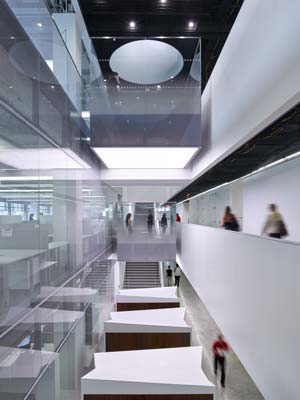
The Bloomberg Center interior. Credit: Matthew Carbone for Morphosis
The art-in-architecture program is a key component of The Bloomberg Center, with newly commissioned works throughout the building by artists Alison Elizabeth Taylor, Michael Riedel, Matthew Ritchie, and Matthew Day Jackson. The building also features a space designed specifically to house a Works Projects Administration (WPA) Federal Art Project mural by Ilya Bolotowsky from the decommissioned Goldwater Memorial Hospital previously on the Cornell Tech site, as well as a ground-floor cafe that is open to the public.
Arup provided multiple consultancy services on the project, including structural, mechanical, electrical, plumbing and fire protection engineering, acoustic and audio-visual consulting, communications, façade, lighting/daylighting design, security and smart building consulting, as well as key sustainability, LEED, and net-zero energy goal consulting.
“We are entering a new era for tech in New York, and the Cornell Tech campus is at the heart of it,” said Andrew Winters, Cornell Tech’s Director of Capital Projects. “The Bloomberg Center is our main academic hub on campus and, inspired by the Bloomberg model, we’re reinforcing our commitment to innovation and sustainability by pushing the boundaries of current energy efficiency practices and setting a new standard for building in New York.”
The Cornell Tech Roosevelt Island campus is an entire academic environment designed with both innovation and sustainability in mind. “As Cornell Tech’s first academic building, The Bloomberg Center is particularly influential,” noted Arup Project Manager Tom Rice. “It was very gratifying to work so closely with Morphosis and Cornell to deliver an overall design that pays careful attention to flexibility and integration, while ensuring a building energy performance that is revolutionary in terms of sustainability standards.”
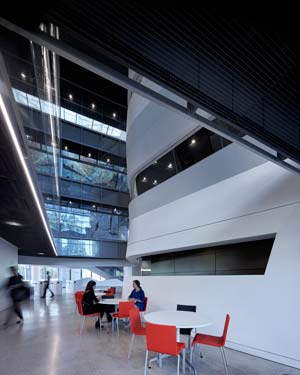
The Bloomberg Center ground floor. Credit: Matthew Carbone for Morphosis
The building is not only targeting an ambitious LEED Platinum certification, but also the aspiration of net-zero energy levels as part of the campus’s broader sustainability program. Net-zero energy distinction requires enough energy to be produced on-site to offset all of the annual building energy consumption and is a design feature that is particularly difficult to achieve in buildings that are in constant use. Early in the design process, Arup set an energy use intensity (EUI) target that was used as a benchmark throughout the project. Final energy models estimated a site EUI of 38.5 kBtu/ft2/year and a source EUI of 90.5 kBtu/ft2/year, levels that are exceptionally low for a building of this type.
Using a stepped approach to reach the project’s low-energy goals, the design team’s first priority was reducing energy demand as much as possible through both load reductions and passive- and energy-efficient design, with renewable energy then employed to power much of the building’s systems. As part of this, the building is designed to be completely electric, utilizing an extensive geothermal system that makes use of highly efficient, electrically-powered ground-source heat pumps, as well as a rooftop array of photovoltaic panels. Additionally, the façade design went beyond the fundamental aspects of establishing continuity of waterproofing and insulation; façade systems were carefully selected to manage daylight, to maximize insulation, and to conserve cooling and heating loads with passive means. Careful attention to detail in the design phase facilitated a unique stud-wall panel system, which mitigated thermal bridging and established continuity of insulation at interlocking joints, which, at the same time, enhances the unique quality of the building and its spatial experiences.
Complementing the careful design to work towards the goal of net-zero standards is the consideration of smart building design. Arup worked closely with Cornell Tech and Morphosis to insure the building itself could be used as a teaching tool for smart buildings, big data, IoT, AI, and other applications. All of the building data from every system will contribute to a “data lake” from which students, researchers, and instructors can create products, applications, and experiments for the built environment.
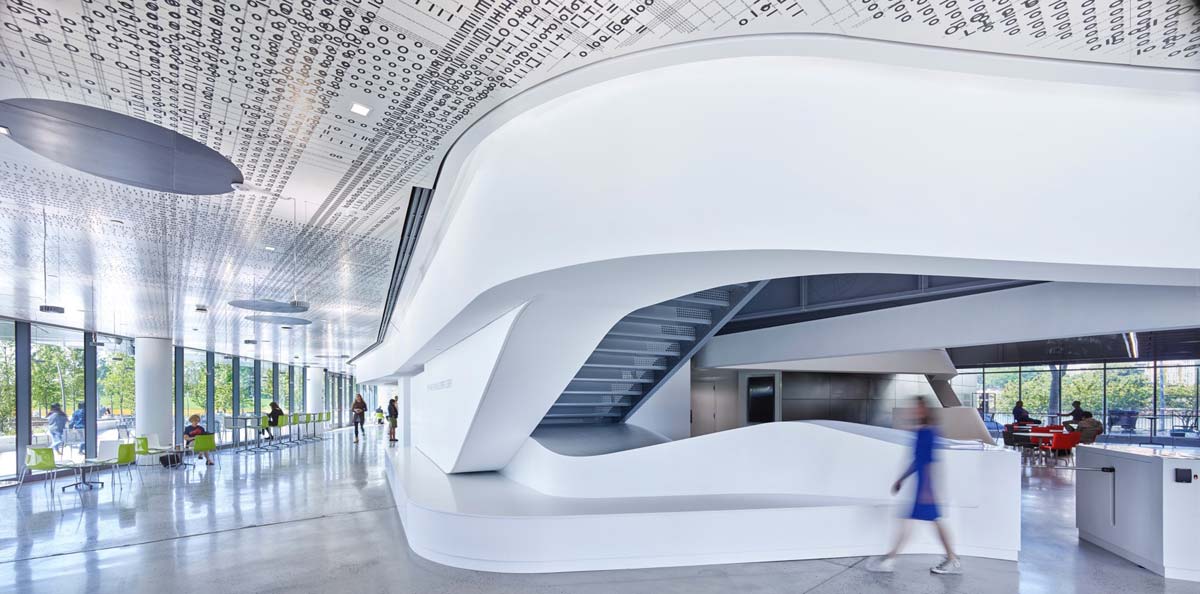
The Bloomberg Center lobby. Credit: Matthew Carbone for Morphosis
“The Bloomberg Center links Cornell University’s and Cornell Tech’s communities, connecting its upstate and downstate locations and resources to foster new research, form new industries, and start new businesses,” stated Ung-Joo Scott Lee, Principal at Morphosis. “Cornell University’s leadership and core mission in advancing sustainability further links the two campuses together and, working in close collaboration with Arup, our team looks to demonstrate that high-performing, net-zero buildings are not only critical for our built environment but ultimately provide healthier, more productive, and greater collaborative environments.”
About Arup
Arup provides planning, engineering, design, and consulting services for the most prominent projects and sites in the built environment. Since its founding in 1946, the firm has consistently delivered technical excellence, innovation, and value to its clients, while maintaining its core mission of shaping a better world. Arup opened its first US office more than 30 years ago and now employs 1,400 people in the Americas. The firm’s employee-ownership structure promotes ongoing investment in joint research to yield better outcomes that benefit its clients and partners. Visit Arup’s website, www.arup.com, and the online magazine of Arup in the Americas, doggerel.arup.com, for more information.

